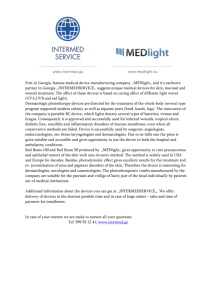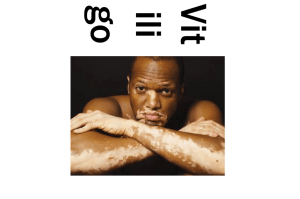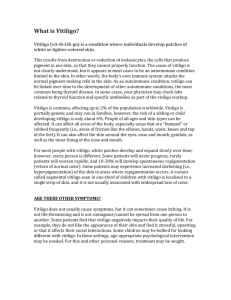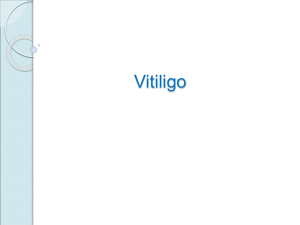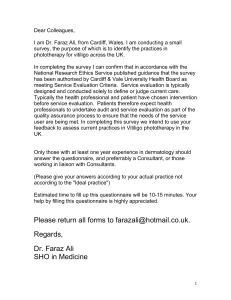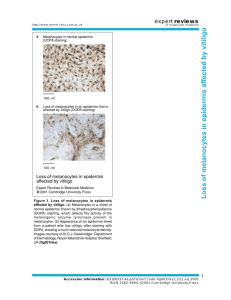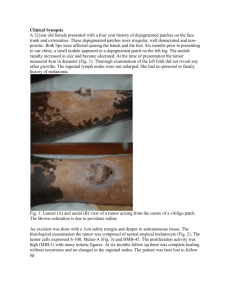VITILIGO TREATMENT GUIDELINES - Vitiligo Research Foundation
advertisement
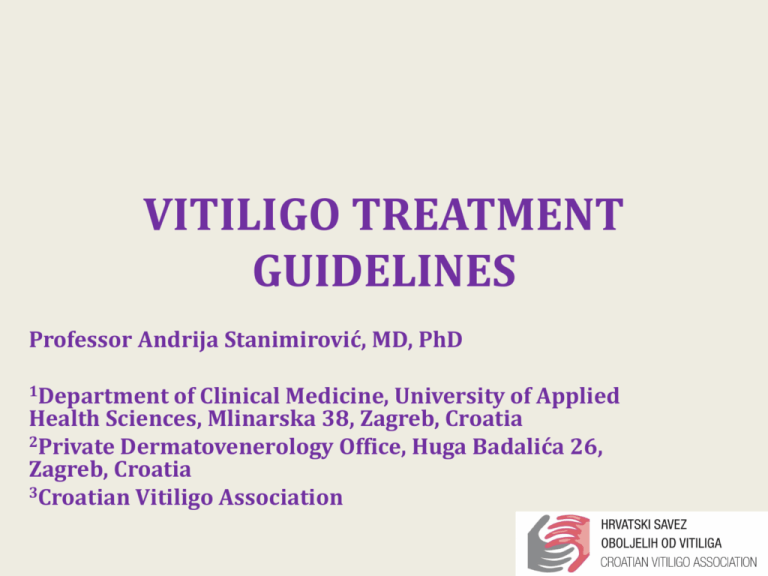
VITILIGO TREATMENT GUIDELINES Professor Andrija Stanimirović, MD, PhD 1Department of Clinical Medicine, University of Applied Health Sciences, Mlinarska 38, Zagreb, Croatia 2Private Dermatovenerology Office, Huga Badalića 26, Zagreb, Croatia 3Croatian Vitiligo Association Why guidelines in medicine? • Systematically developed statements that assist the clinician in choosing the most appropriate therapy for a specific condition • Tools to reduce inappropriate care • Tools which control geographic variations in practice patterns • Tools which make the use of health care resources more effective • Recommendations linked directly to scientific evidence of effectiveness Guideline Algorithm Chronic plaquetype psoriasis Calcineurin inhibitors Coaltar basic therapy Corticosteroids mild BSA < 10% PASI < 10 P Topical therapy Dithranol Laser Tazarotene Vitamin D3 moderate BSA > 10% PASI > 10 P Combined: Climate balneotherapy Calcineurin inhibitors Cyclosporine Evidence-based (S3) severe Guidelines for the Treatment of Psoriasis Vulgaris Nast et al., J Dtsch Dermatol Ges 5 (Suppl. 3), 2007 Nast et al., Arch Dermatol Res 299.111-138, 2007 (short version) Systemic therapy Fumaric Acid Esters Efalizumab Methotrexate Etanercept Retinoids UV Infliximab Adalimumab Ustekinumab RESULT OF: Poor criteria (diagnosis and effectiveness) sharing Poor outcomes sharing Variable therapy duration Home-made non-uniform trial designs • Total of 96 studies with 4512 participants state: 24/02/15 • 21/39 (54%) of the new studies assessed new treatments, most of which involved the use of light • NB-UVB light - used in 35/96 (36% of all included studies), alone/in combination with other therapies the best results • The majority of studies (53/96, 55%), most of which were of combination treatments with light, assessed > 75% repigmentation • 9/96 (9%)- the quality of life of participants • The majority of all studies (65/96, 68%) reported adverse effects, mainly for topical treatments • Neither mometasone furoate nor hydrocortisone produced adverse effects • The majority of the studies reporting successful repigmentation = combinations of various interventions with light Where do we stand in vitiligo? • Lack of definitive and completely effective therapies • The most effective treatments: phototherapy and combined therapy • THERAPEUTIC GOALS: – Stopping the progression of the disease – Satisfactory repigmentation – Maintenance of the pigment GUIDELINES FOR VITILIGO – FIRST STEPS • TEAM (Njoo et al): – 1 main investigator – 2 staff members of the Department of Dermatology – Clinical epidemiologist – Clinical librarian – External expert on pigmentary disorders • EVALUATION: questionnaire + structured interview = 14 questionnaires/23 sent • Meta-analysis of the literature (63 studies localized vitiligo,117 studies - generalized vitiligo) GUIDELINES FOR VITILIGO – FIRST STEPS GUIDELINES FOR VITILIGO – FIRST STEPS GUIDELINES FOR VITILIGO – FIRST STEPS • The guidelines were followed for most adults • Children with vitiligo 52% followed the guidelines (no further distinction was made in the several clinical types or the disease activity) Nordlund JJ 2008 Nordlund JJ 2008 PRESENT THERAPEUTIC ALGORITHMS FOR VITILIGO TREATMENT • Gawkrodger DJ, Ormerod AD, Shaw L, et al. Algorithm for the management of vitiligo in adults and children by non-specialists in UK. Postgrad Med J. 2010;86:466-71. • Felsten LM, Alikhan A, Petronic-Rosic V. Vitiligo: a comprehensive overview Part II: treatment options and approach to treatment. J Am Acad Dermatol. 2011;65:493-514. • Taieb A, Alomar A, Böhm M, et al. VITILIGO EUROPEAN TASK FORCE. Guidelines for the management of vitiligo: the European Dermatology Forum Consensus. Br J Dermatol. 2013;168:5-19. PRESENT THERAPEUTIC ALGORITHMS FOR VITILIGO TREATMENT-ctd. • Oiso N, Suzuki T, Wataya-Kaneda M, et al. Proposed algorithm for the management of vitiligo in Japan. J Dermatol. 2013;40:344-54. • Stanimirović A, Šitum M, Kostović K, et al. Proposal for Guidelines for the Treatment of Vitiligo in Croatia. Global Journal of Dermatology and Venereology 2014;2(1):19-26. Algorithm for the management of vitiligo in adults and children by non-specialists in UK. (Modified from: Gawkrodger DJ et al. Source: Postgrad Med J. 2010;86:46671.) Diagnosis of vitiligo: - Classical presentation: primary care - Atypical presentations: dermatologist - Adults: thyroid blood tests a) NO TREATMENT OPTION: • ADULTS AND CHILDREN WITH SKIN TYPES I and II NO ACTIVE TREATMENT OTHER THAN CAMOUFLAGE AND SUNSCREENS Algorithm for the management of vitiligo in adults and children by non-specialists in UK. (Modified from: Gawkrodger DJ et al. Source: Postgrad Med J. 2010;86:46671.) b) TOPICAL TREATMENT: 1. ADULTS WITH RECENT ONSET OF VITILIGO AND CHILDREN: POTENT/VERY POTENT TOPICAL STEROIDS - no more than 2 months (skin atrophy - common side effect) 2. ADULTS: TOPICAL PIMECROLIMUS (better safety profile) 3. CHILDREN: TOPICAL PIMECROLIMUS/TACROLIMUS (better safety profile) 4. ADULTS SEVERELY AFFECTED BY VITILIGO: DEPIGMENTATION (only by a specialist dermatology unit) Algorithm for the management of vitiligo in adults and children by non-specialists in UK. (Modified from: Gawkrodger DJ et al. Source: Postgrad Med J. 2010;86:46671.) c) PHOTOTHERAPY, SYSTEMIC THERAPY AND SURGICAL TREATMENTS: •Only in specialist units •SURGICAL TREATMENTS- NOT RECOMMENDED IN CHILDREN d)PSYCHOLOGICAL TREATMENT: •Assessment of the psychological and QoL effects of vitiligo on adults and children •Psychological interventions •Parents of children with vitiligo - psychological counseling Felsten LM, Alikhan A, Petronic-Rosic V. Vitiligo: a comprehensive overview Part II: treatment options and approach to treatment. J Am Acad Dermatol. 2011;65:493-514. •TOPICAL STEROIDS OR •TOPICAL STEROIDS + TOPICAL VITAMIN D3 ANALOGS 1st line therapy: treatment of naive vitiligo ALTERNATIVE: •TOPICAL CALCINEURIN INHIBITORS •SYSTEMIC STEROIDS •TOPICAL L-PHENYLALANINE •TOPICAL ANTIOXYDANTS AND MITOCHONDRIAL STIMULATING CREAM •NATURAL SUNLIGHT WITH PO KHELLIN RAPIDLY PROGRESSIVE VITILIGO → SYSTEMIC STEROIDS RECALCITRANT LESIONS ON EXTREMITIES→ TACROLIMUS NIGHTLY UNDER OCCLUSION Felsten LM, Alikhan A, Petronic-Rosic V. Vitiligo: a comprehensive overview Part II: treatment options and approach to treatment. J Am Acad Dermatol. 2011;65:493-514. •NBUVB + TOPICAL CALCINEURIN INHIBITORS ALTERNATIVE: •ADJUNCT NBUVB THERAPY WITH PO ANTIOXYDANTS •SYSTEMIC STEROIDS /POLYPODIUM LEUCOTOMOS EXTRACT •PUVA •SYSTEMIC STEROIDS •TOPICAL VITAMIN D3 ANALOGS •PO KHELLIN •PO L-PHENYLALANINE/TOPICAL L-PHENYLALANINE 2nd line therapy: vitiligo recalcitrant to first line therapy Felsten LM, Alikhan A, Petronic-Rosic V. Vitiligo: a comprehensive overview Part II: treatment options and approach to treatment. J Am Acad Dermatol. 2011;65:493-514. 308 nm LASER + TOPICAL STEROIDS ALTERNATIVE: •ADJUNCT 308 nm LASER + TOPICAL CALCINEURIN INHIBITORS 3rd line therapy: vitiligo unsuccessfully treated with total body phototherapy Felsten LM, Alikhan A, Petronic-Rosic V. Vitiligo: a comprehensive overview Part II: treatment options and approach to treatment. J Am Acad Dermatol. 2011;65:493-514. •BLISTER GRAFT •SPLIT THICKNESS SKIN GRAFT •PUNCH GRAFT •AUTOLOGOUS MELANOCYTE TRANSPLANT SEGMENTAL VITILIGO: TREATMENT AS ABOVE, HE-NE LASER AS 3rd line therapy GENERALIZED VITILIGO: TREATMENT AS ABOVE, DEPIGMENTATION AGENTS FOR RECALCITRANT DISEASE 4th line therapy: vitiligo recalcitrant to 1st, 2nd and 3rd line therapy CAMOUFLAGE AND PSYCHOTHERAPY SHOULD BE OFFERED TO PATIENTS AT ALL STAGES OF TREATMENT Guidelines for the management of vitiligo: the European Dermatology Forum Consensus. (Modified from Taieb A et al. Source: Br J Dermatol. 2013;168:5-19.) a)Simplified algorithm for NSV Diagnosis of NSV: Avoidance of triggering factors INITIAL RECOMMENDATION NB-UVB (3 months) + - /systemic/topical therapies (LOCAL CS/TIM ) Camouflage STABILIZATION STABILIZATION AND REPIGMENTATION: NB-UVB (9 months) STABILIZATION AND REPIGMENTATION CESSATION: SURGICAL TREATMENT Guidelines for the management of vitiligo: the European Dermatology Forum Consensus. (Modified from Taieb A et al. Source: Br J Dermatol. 2013;168:5-19.) a)Simplified algorithm for NSV PROGRESSION • CS MINIPULSE (3-4 months) • OTHER IMMUNOSUPPRESSANTS STABILIZATION AND REPIGMENTATION AFTER PERIOD OF PROGRESSION: NBUVB (9 months) NO REPIGMENTATION, KOEBNER PHENOMENON +: DEPIGMENTATION STABILIZATION WITH OR WITHOUT REPIGMENTATION, KOEBNER PHENOMENON -: SURGICAL TREATMENT Guidelines for the management of vitiligo: the European Dermatology Forum Consensus. (Modified from Taieb A et al. Source: Br J Dermatol. 2013;168:5-19.) b) Algorithm for SV Diagnosis of SV: Avoidance of triggering factors INITIAL RECOMMENDATION: LOCAL CS/TIM STABILIZATION AND REPIGMENTATION: NO THERAPY STABILIZATION STABILIZATION WITH OR WITHOUT REPIGMENTATION: SURGICAL TREATMENT Guidelines for the management of vitiligo: the European Dermatology Forum Consensus. (Modified from Taieb A et al. Source: Br J Dermatol. 2013;168:5-19.) b) Algorithm for SV PROGRESSION NB-UVB MEL STABILIZATION AND REPIGMENTATION AFTER PERIOD OF PROGRESSION: NO THERAPY NO REPIGMENTATION, KOEBNER PHENOMENON +: CAMOUFLAGE STABILIZATION WITH OR WITHOUT REPIGMENTATION, KOEBNER PHENOMENON -: SURGICAL TREATMENT Proposed algorithm for the management of vitiligo in Japan. (Modified from Oiso N et al. Source: J Dermatol. 2013;40:344-54.) Diagnosis of vitiligo: • VASI score • Age • Affected duration a) Complication (+) refer patient to specialist: Treatment of vitiligo as shown in complication (-) b) Complication (-) Camouflage should be available for all patients Proposed algorithm for the management of vitiligo in Japan. (Modified from Oiso N et al. Source: J Dermatol. 2013;40:344-54.) 1st therapeutic option: NB-UVB/PUVA +/- TOPICAL CORTICOSTEROIDS/ TOPICAL VITAMIN D3 ANALOGUES 2nd therapeutic option: TOPICAL VITAMIN D3 ANALOGUES + SUN EXPOSURE 3rd therapeutic option: 308-nm EXCIMER LASER/LIGHT 4th therapeutic option: SKIN GRAFTING STABLE (5 years or more after occurence) Proposed algorithm for the management of vitiligo in Japan. (Modified from Oiso N et al. Source: J Dermatol. 2013;40:344-54.) 1st therapeutic option: TOPICAL VITAMIN D3 ANALOGUES 2nd therapeutic option: TOPICAL CORTICOSTEROIDS 3rd therapeutic option: SKIN GRAFTING PROGRESSIVE (5 ≤ years after occurence, or variable in size) on patient 15 ≤ years old with lesions on face Proposed algorithm for the management of vitiligo in Japan. (Modified from Oiso N et al. Source: J Dermatol. 2013;40:344-54.) 1st therapeutic option: TOPICAL CORTICOSTEROIDS 2nd therapeutic option: TOPICAL TACROLIMUS 3rd therapeutic option: TOPICAL VITAMIN D3 ANALOGUES + SUN EXPOSURE 4th therapeutic option: SKIN GRAFTING PROGRESSIVE (5 ≤ years or after occurence, or variable in size) on patient 15 ≤ years old with lesions on trunk and extremities Proposed algorithm for the management of vitiligo in Japan. (Modified from Oiso N et al. Source: J Dermatol. 2013;40:344-54.) 1st therapeutic option: NB-UVB/PUVA +/- TOPICAL CORTICOSTEROIDS/ TOPICAL VITAMIN D3 ANALOGUES 2nd therapeutic option: 308-nm EXCIMER LASER/LIGHT OR TOPICAL VITAMIN D3 ANALOGUES + SUN EXPOSURE 3rd therapeutic option: ORAL CORTICOSTEROIDS / IMMUNOSUPPRESSIVE AGENTS 4th therapeutic option: SKIN GRAFTING PROGRESSIVE (5 ≤ years after occurence, or variable in size) on patient 16 ≥ years old Dear God when will this presentation end!? DEATH BY POWERPOINT! Falabella R, Barona MI. Update on skin repigmentation therapies in vitiligo. Pigment Cell Melanoma Res. 2009;22:42-65. Falabella R, Barona MI. Update on skin repigmentation therapies in vitiligo. Pigment Cell Melanoma Res. 2009;22:42-65. Falabella R, Barona MI. Update on skin repigmentation therapies in vitiligo. Pigment Cell Melanoma Res. 2009;22:42-65. • • • • • • • 470 vitiligo patients, less than 10% affected skin Tacrolimus 0.1% ointment Pimecrolimus 1% cream Betamethasone dipropionate 0.05% cream Calcipotriol ointment 50mcg/g 10% L-phenylalanine cream ALONE/IN COMBINATION WITH 311-nm NB-UVB MICROPHOTOTHERAPY Percentage of repigmentation in patients treated with 311-nm NBUVB microphototherapy(BIOSKIN® ) alone or in combination, or with active topical treatment alone Treatment (n° of patients) Excellent (>75%) Marked (50-75%) Moderate (25-50%) Minimal (<25%) Group 1: BIOSKIN® alone (100) 72% 19.8% 4.6% 3.6% Group 2: 0.1% Tacrolimus + BIOSKIN® (59) 76.5% 18.2% 3.3% 2% Group 3: 1% Pimecrolimus + BIOSKIN® (63) 76.1% 20.1% 2.7% 1.1% Group 4: Betamethasone dipropionate 0.05% + BIOSKIN® (28) 90.2% 6.7% 2.2% 0.9% Group 5: Calcipotriol ointment 50 mcg/g + BIOSKIN® (60) 75.6% 14.1% 7.4% 2.9% Group 6: 10% L-Phenylalanine + BIOSKIN® (60) 74.8% 11.3% 10.1% 3.8% Group 7: 0.1% Tacrolimus alone (22) 61% 16.1% 18.4% 4.5% Group 8: 1% Pimecrolimus alone (19) 54.6% 18.4% 21.7% 5.3% Group 9: Betamethasone dipropionate 0.05% alone (23) 71.2% 25% 2.1% 1.7% Group 10: Calcipotriol ointment 50 mcg/g (18) 59.1% 10.6% 27.1% 3.2% Group 11: 10% L-Phenylalanine alone (18) 29.3% 8.1% 55% 7.6% Vitiligo Therapy 2014/15 General Short Remarks TOPICAL CORTICOSTEROIDS • Limited, non-facial involvement: potent TCS, once daily for 4 months or 15 days/month for 6 months • First and safest choice: potent TCS rather than super potent • Suspicious systemic absorption: consider mometasone furoate or methylprednisolone aceponate • Facial involvement: consider topical calcineurin inhibitors (TCI) rather than TCS TOPICAL CALCINEURIN INHIBITORS • New and fast, actively spreading lesions and involvement of face/neck areas • Twice daily, initially for 6 months, both adults and children • Safety profile is better concerning the risk of skin atrophy • During the treatment: moderate but daily sun exposure, without previous cream application • If effective, consider prolonged treatment (↑12 months) NBUVB AND TARGETED PHOTOTHERAPIES • Total body NB UVB for NSV- arrest and repigment vitiligo • Targeted phototherapies: localized vitiligo, recent onset vitiligo & childhood vitiligo • Maximum cycle duration- 1 year for adults and 6 months for children. One year interruption between cycles! • Halting of treatment: if no results in 3 months or if ↓ 25% repigmentation in 6 months • Maintenance treatment-not recommended • Regular follow- ups necessary PUVA AND PHOTOCHEMOTHERAPY • Oral PUVA-second or third line therapy in adults • 12 to 24 months therapy • Topical PUVA-very low dosage psoralens creams • However, actually relatively opsolent COMBINATION TREATMENTS • Topical steroids and phototherapy • In addition peroral antioxidants • For difficult to treat areas such as bony prominences, hands and feet • Highly potent topical steroids once a day (3 weeks out of 4) for the 3 first months of phototherapy • Whole time peroral antioxidants COMBINATION TREATMENTS-ctd • Topical calcineurin inhibitors and phototherapy • Effective and provides better results that the two treatments separately alone • Should be used with precautions due to carcinogenicity ? • Use of adequate photoprotection due to the lack of data on long term safety (or not) of combination of TCI and UV COMBINATION TREATMENTS-ctd Vitamin D analogues and phototherapy: • Not recommended, data of efficacy lacking Phototherapy and peroral therapy: • Phototherapy+oral antioxidants possibly beneficial Phototherapy after surgery: • NB-UVB or PUVA should be used for 4 weeks after melanocyte transplatation ORAL STEROIDS/OTHER IMMUNUNOSUPPRESSANTS ORAL CORTICOSTEROIDS MINI PULSE: • For stabilization of vitiligo - not useful as repigmentating therapy • For fast spreading vitiligo- weekend OMP (2.5 mg/day) of dexamethasone before phototherapyuseful as disease halting therapy • Optimal duration of OMP to stop vitiligo progression is 3-6 months OTHER IMMUNUNOSUPPRESSANTS/ BIOLOGICS Cyclophosphamide, Cyclosporine, MTX, Tetracyclines, & Anti-TNF-α: • Currently not yet recommended due to lack of data and because of the possible side effects Statins - promising Low dose cytokines-promising AFAMELATONIDE • Simplified form of alpha-melanocyte stimulating hormone (α-MSH) - stimulates melanocytes to grow and produce melanin pigment • Afamelatonide + NBUVB = faster repigmentation? OTHER SYSTEMIC INTERVENTIONS: ANTIOXYDANTS • • • • • • Vitamin E Vitamin C Ubiquinone Lipoic acid Polypodium Leucotomos Ginko biloba etc. o Antioxidant supplementation could be useful during UV therapy and reactivation phases o Combination therapy with UVB and topical therapy is recommended SURGERY • For NSV- patients with stable disease and negative Koebner phenomenon • Risk of relapse? • For SV and other localized vitiligo forms-after failure of medical interventions • Only in specialized units Stanimirović A, Šitum M, Kostović K, Bulat V, Kovačević M, Kaštelan M, Puizina-Ivić N, Pustišek N, Čulav-Košćak I. Proposal for Guidelines for the Treatment of Vitiligo in Croatia. Global Journal of Dermatology and Venereology 2014;2(1):19-26. POTENT TOPICAL CORTICOSTEROIDS OR TOPICAL CALCINEURIN INHIBITORS (genital area and armpits in adults and children) OR TOPICAL CORTICOSTEROIDS + TOPICAL VITAMIN D ANALOGUES OR MINI ORAL PULSED CORTICOSTEROID TREATMENT (progressive, fast spreading vitiligo) 1st therapeutic recommendation Stanimirović A, Šitum M, Kostović K, Bulat V, Kovačević M, Kaštelan M, Puizina-Ivić N, Pustišek N, Čulav-Košćak I. Proposal for Guidelines for the Treatment of Vitiligo in Croatia. Global Journal of Dermatology and Venereology 2014;2(1):19-26. NB-UVB 311nm PHOTOTHERAPY OR NB-UVB 311nm PHOTOTHERAPY + POTENT TOPICAL CORTICOSTEROIDS OR NB-UVB 311nm PHOTOTHERAPY + TOPICAL CALCINEURIN INHIBITORS OR NB-UVB 311nm PHOTOTHERAPY + PERORAL THERAPY: CORTICOSTEROIDS, ANTIOXYDANTS, Polypodium Leucotomos EXTRACT 2nd therapeutic recommendation Stanimirović A, Šitum M, Kostović K, Bulat V, Kovačević M, Kaštelan M, Puizina-Ivić N, Pustišek N, Čulav-Košćak I. Proposal for Guidelines for the Treatment of Vitiligo in Croatia. Global Journal of Dermatology and Venereology 2014;2(1):19-26. PUVA PHOTOTHERAPY (only in specialist units) 3rd therapeutic recommendation Stanimirović A, Šitum M, Kostović K, Bulat V, Kovačević M, Kaštelan M, Puizina-Ivić N, Pustišek N, Čulav-Košćak I. Proposal for Guidelines for the Treatment of Vitiligo in Croatia. Global Journal of Dermatology and Venereology 2014;2(1):19-26. SURGICAL TREATMENT (for inactive vitiligo on prominent sites - i.e. face, hands): • BLISTER GRAFT • PUNCH GRAFT • SPLIT THICKNESS SKIN GRAFT • AUTOLOGOUS MELANOCYTE SUSPENSION TRANSPLANT 4th therapeutic recommendation Camouflage and cognitive behavioral therapy should be available for all patients. Lotti T, Merkel A, Korobko I, Šitum M, Keqiang Li, Stanimirović A, Putin V, Valle J, Obama B, Hercogova J, Castro F. World Consensus Guidelines for the Treatment of Vitiligo. Space Intergallactic Journal of Dermatology and Venereology 2016;4(1):27-31. croatia.vitiligo.org@gmail.com http://vrfoundation.org/
